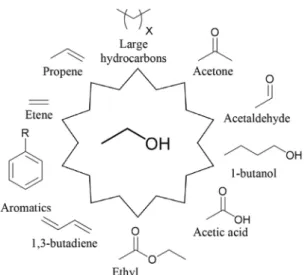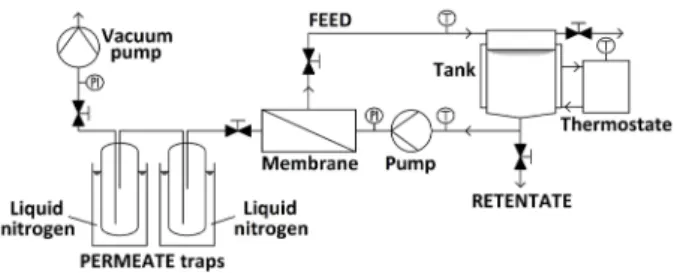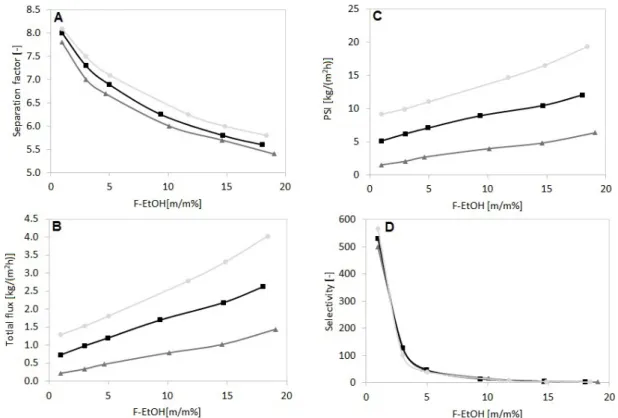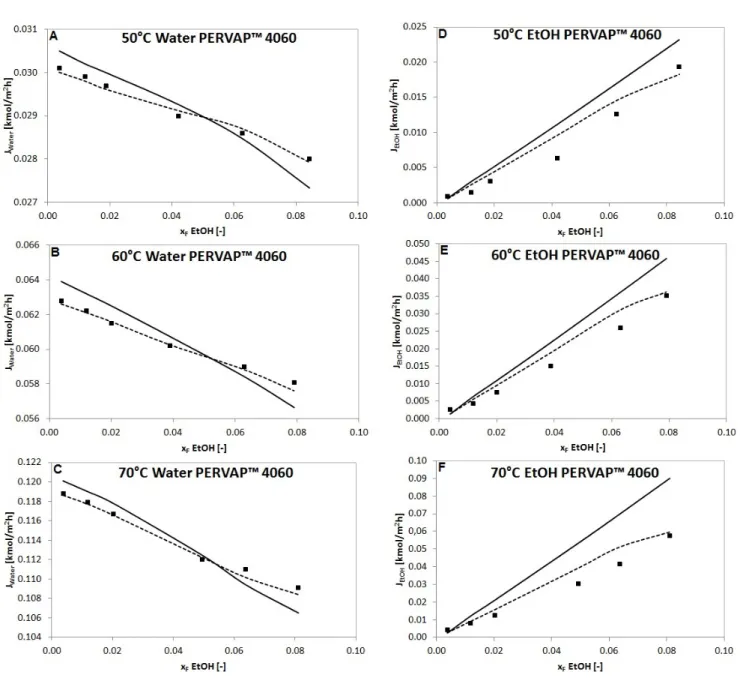Cite this article as: Haaz, E., Valentinyi, N., Tarjani, A. J., Fozer, D., Andre, A., Khaled Mohamed, S. A., Rahimli, F., Nagy, T., Mizsey, P., Deak, Cs., Toth, A. J.
"Platform Molecule Removal from Aqueous Mixture with Organophilic Pervaporation: Experiments and Modelling", Periodica Polytechnica Chemical Engineering, 2018. https://doi.org/10.3311/PPch.12151
Platform Molecule Removal from Aqueous Mixture with Organophilic Pervaporation: Experiments and Modelling
Eniko Haaz
1, Nora Valentinyi
1, Ariella Janka Tarjani
1, Daniel Fozer
1, Anita Andre
1, Selim Asmaa Khaled Mohamed
1, Fuad Rahimli
1, Tibor Nagy
1, Peter Mizsey
1,2, Csaba Deak
2, Andras Jozsef Toth
1*1 Environmental and Process Engineering Research Group, Department of Chemical and Environmental Process Engineering, Faculty of Chemical Technology and Biotechnology Budapest University of Technology and Economics, H-1111 Budapest, Műegyetem rkp. 3., Hungary
2 University of Miskolc, H-3513 Miskolc, Egyetemváros, Hungary
* Corresponding author, email: ajtoth@envproceng.eu
Received: 04 March 2018, Accepted: 18 April 2018, Published online: 04 May 2018
Abstract
The work is motivated by a separation problem, which is ethanol removal from aqueous mixtures with membranes. Ethanol can be considered as promising biomass based platform molecule. The platform molecule includes several building-block chemicals grouped together, resulting in a range of downstream chemical products. To solve the target, organophilic pervaporation system is investigated using benchmarked Sulzer PERVAP™ 4060 membranes. Separation factors, total permeation fluxes, permeances and selectivities are experimentally determined. The target of this work is to parameter estimation for semi-empirical pervaporation model. The measured data are evaluated with improved pervaporation model by Valentinyi et al. [1]. Three different polymeric flat sheet membranes are investigated, PERVAP™ 4060, PERVAP™ 1060 and CELFA-CMG-OG010. It is found that the model can be applied also for each organophilic separation case.
Keywords
organophilic pervaporation, ethanol removal, platform molecule, mathematical modelling, parameter estimation
1 Introduction
As the era of fossil oil nears its end and environmental pertains describing to the extraction of non-sustainable fossil feedstocks use pressure to the petrol sector, new sustainable feedstocks for chemicals and materials will be appropriate. The conventional chemical industry relies mainly on a small set of base chemical building blocks that are fabricated globally on a mighty quantity [2-5].
Farmer and Mascal [2] have defined these resources as platform molecules with the followings: “A bio-based (or bio-derived) platform molecule is a chemical compound whose constituent elements originate wholly from bio- mass (material of biological origin, excluding fossil carbon sources), and that can be utilized as a building block for the production of other chemicals”. Ethanol (EtOH) is men- tioned as platform molecule, it is determined the constit- uent of this biomass molecule is derived from sugars [2].
Fig. 1 shows more ethanol-based organic molecules [6].
Bozel and Petersen [7] have classified ethanol into the group of revisited platform molecules [8]. They have also
summarized the main criteria for the inclusion and result- ing technology needs of top 10 platform molecules. In the case of ethanol the most important recommendations are the optimization of fermentation organisms, development of biochemical production of alcohols from biomass and alcohol-water separations techniques [7].
This research focuses on the third recommenda- tion, which is the alcohol removal from water mixtures.
Pervaporation (PV) is selected for investigation of eth- anol from aqueous mixtures. Pervaporation has more green specialties against to other traditional processes, such as distillation [9, 10]. There are simply actualiza- tion, energy-saving and no-pollution effects, furthermore no need for extra material to add for the separation [11].
Pervaporation method applied for organic-organic separa- tions, removal of low concentration organic from its aque- ous mixtures and dehydration of organics [12].
The separated liquid mixture is vaporized at vacuum on
the permeate side of dense membranes and the transport
process can be described as sorption and diffusion phe- nomena. Depending on the affinity of permeating compo- nent, this method can be specified into main areas: hydro- philic PV and organophilic PV. Removal of organic, for our cases ethanol, organophilic membranes are applied.
PV can be described by certain equations. The partial flux is calculated applying the following formula [13]:
J
i= P
i( ∆ t A ⋅ ) (1)
where P
iis the partial weight of component i in the per- meate product, Δ t is the time of duration of separation pro- cess and A is the effective membrane area.
Separation factor is determined by Eq. (2) [13]:
α = ( y
i( 1 − x
i) ) ( x
i( 1 − y
i) ) (2)
where α is separation factor (dimensionless), x
iis weight fraction of water in feed and y
iis weight fraction of water of permeate. Pervaporation Separation Index (PSI) is specified [13]:
PSI J = ⋅ ( α − 1 ) (3)
The efficiency of pervaporation membranes can be deter- mined by the permeance as partial flux normalized for driv- ing force the pressure difference-normalized flux [13-15]:
P
iδ = J
i( ( γ
i0⋅ x p
i0⋅
i0) − ( y p
i⋅
3) ) (4)
The membrane selectivity β is calculated as the ratio of permeances [13-15]:
β = ( P
iδ ) ( P
jδ ) (5)
The ethanol removal is the actual task. As for the liter- ature survey some papers were published in the separation of ethanol-water mixture by organophilic pervaporation.
Table 1 summarizes a comparison of experimental data for the organophilic pervaporation of the ethanol-water mixture with polydimethylsiloxane (PDMS) membranes.
The most widespread benchmarked material of organo- philic PV is PDMS and the research focuses on the invest- ment of this membranes.
The focus of this research is to represent the emerg- ing method of organophilic PV and provide adequate understanding of the process for successful explanation of experimental data. The aim of this work is to investi- gate polymeric PV membranes and to fit parameters for semi-empirical transport model.
Fig. 1 Ethanol as a platform molecule [6]
Table 1 Comparison of experimental data with composite PDMS membranes with different supports and without fillers for organophilic pervaporation of ethanol-water mixture
Membranes T FEtOH Jtotal α PSI
Reference [°C] [m/m%] [kg/(m2h)] [-] [kg/(m2h)]
PDMS - PTFE s. 30 2 0.10 10.0 0.9 Zhang et al. [16]
PDMS - CA s. 40 5 1.14 9.3 9.5 Luo et al. [17]
PDMS - PA s. 45 4 1.85 8.5 13.9 Shi et al. [18]
PDMS - CA s. 40 5 1.30 8.5 9.8 Li et al. [19]
PDMS - PS s. 42 5 1.44 6.7 8.2 Zhang et al. [20]
PDMS - PS s. 50 8 0.26 6.4 1.4 Guo et al. [21]
PDMS - PS s. 45 4 1.60 5.0 6.4 Shi et al. [18]
PDMS - PVDF s. 40 10 8.00 2.2 9.6 Chang et al. [22]
PDMS - CA s. 50 0.3 2.80 3.0 5.6 Mohammadi et al. [23]
PDMS 40 6 0.10 8.7 0.8 Naik et al. [24]
PDMS 30 5 0.05 8.0 0.3 Slater et al. [25]
PDMS graft copol. 48 6.6 0.03 6.6 0.2 Kashiwagi et al. [26]
PDMS 50 5 0.08 4.2 0.3 Lazarova et al. [27]
2 Materials and methods
The laboratory apparatus is P-28 membrane unit from CM-Celfa Membrantechnik AG (see Fig. 2). The equip- ment has 28 cm
2effective area (A). Cross-flow circulation is achieved at constant value of ∼ 182 L/h and the size of the feed tank is 500 mL [13].
The isotherm conditions are adjusted with an ultrath- ermostat. The vacuum on the permeate side is maintained with VACUUMBRAND PC2003 VARIO vacuum pump and kept up at 2 Torr (3 mbar). The permeate is gathered in two traps connected in series and cooled with liquid nitro- gen to hinder loss of the permeate [13]. The ethanol concen- tration of the feed (F), permeate (P) and retentate (R) are measured with Shimadzu GC2010Plus+AOC-20 autosam- pler gas chromatograph with a CP-SIL-5CB column con- nected to a flame ionization detector, EGB HS 600 head- space apparatus is used for sample preparation [13, 29].
Composite PDMS flat sheet membranes are used in organophilic laboratory experiments. The pervaporation measurements are carried out at six different feed concen- trations and three temperatures with Sulzer PERVAP™
4060, as follows: 1, 3, 5, 10, 15 and 20 weight percent (m/m%) ethanol in feed and 50, 60 and 70°C.
The procedure of Valentinyi et al. [1] is elected for mod- elling of pervaporation, which is a development of basic Rautenbach model [30]. The concentration dependencies of the transport coefficient D
iand the temperature depen- dencies of the pervaporation mean the improvements [13, 31]. Eq. (6) shows the basic equation of the improve- ment PV model:
J D B x p
D B x
i i i i i
i i
= ( + { ⋅ ( ⋅ ) ( ⋅ ) } )
⋅ ⋅ ( ⋅ )
1 1
1 0
1
exp exp
γ γ
ii
( ( p
i1− p
i3) p
i0) (6)
The fundamental Rautenbach model (Model I) and the advanced one (Model II) are applied for modelling of organophilic pervaporation experiments. D
iand acti- vation energies E
iand in the case of improved model B parameters are estimated based on experimental data [13]. In Eq. (6) the exponential B parameter represents the concentration dependencies of the transport coefficients.
Nonlinear estimation is applied by determining a regres- sion custom loss function (Eq. (7)) in STATISTICA® pro- gram environment. The model verification can be taken with objective function (OF), which is minimized the dif- ference of the measured and the modelled values.
OF = ∑
in=1( ( J
i measured,− J
i, modelled) J
i measured,)
2(7)
Further membranes are investigated for parame- ter estimation: Sulzer PERVAP™ 1060 and CELFA- CMG-OG010. The preliminary pervaporation experi- ments are carried out by Molina et al. [32] and conditions of measurements are described in detail in PhD Thesis of Molina [33].
3 Results and discussion
Fig. 3 presents the effect of feed concentration on the per- vaporation achievement of the PERVAP™ 4060 organo- philic membranes at different operating temperatures.
It can be seen that increasing ethanol feed concentra- tion and operating temperature increase the total fluxes.
However, increasing the ethanol concentration decreases the separation factors. The maximal total flux of 4.03 kg/(m
2h) can be reached at 70°C and at the feed eth- anol concentration of 18.4 m/m%. Compared with other literature results (see Table 1), it can be seen PERVAP™
4060 has the highest total flux value and PSI and it fol- lows the tendency of the total flux. Studying Table 1, it can be determined the maximum separator factor of 8.1 is also a high value. Furthermore, selectivity follows the trend of the separator factor.
It can be stated at higher ethanol concentration the sep- aration effectiveness of the organophilic pervaporation membranes are decreased, similar tendency have been already published by Slater et al. [25], Lazarova et al. [27], Vane [34], Chai et al. [35] and Fu et al. [36].
Table 2, Table 3 and Table 4 summarize the estimated values of transport coefficients, activation energies, expo- nential parameters and minimized objective functions of the two models.
Comparison of the measured and calculated partial fluxes are presented in Fig. 4, Fig. 5 and Fig. 6.
Fig. 4, Fig. 5, Fig. 6 and Table 2, Table 3, Table 4 show that Model II is much more applicable for description of organophilic pervaporation than Model I, because the basic model presumes constant D
i. Many authors have
Fig. 2 Flowsheet of CM-Celfa P-28 Membrantechnik AG apparatus in PV mode [13, 28]
Fig. 3 Pervaporation performance as a function of feed concentration at different operating temperatures for PERVAP™ 4060 membrane (50°C: ; 60°C: ; 70°C: )
Table 2 Estimated parameters and minimized objective functions for ethanol–water mixture in the case of PERVAP™ 4060
PERVAP™ 4060 Model I Model II
Water EtOH Water EtOH
Di[kmol/m2h] 0.015 0.076 0.026 0.077
Ei [kJ/kmol] 31386 33082 31363 33090
B [-] -0.73 -0.04
OF [-] 0.0038 0.1580 0.0001 0.1610
Table 3 Estimated parameters and minimized objective functions for ethanol–water mixture in the case of PERVAP™ 1060
PERVAP™ 1060 Model I Model II
Water EtOH Water EtOH
Di[kmol/m2h] 0.003 0.045 0.006 0.072
Ei [kJ/kmol] 62806 33283 62801 35892
B [-] -0.77 -10.60
OF [-] 0.0088 1.1475 0.0020 0.1109
Table 4 Estimated parameters and minimized objective functions for ethanol–water mixture in the case of CELFA-CMG-OG010
CELFA-CMG-OG010 Model I Model II
Water EtOH Water EtOH
Di[kmol/m2h] 0.003 0.024 0.006 0.038
Ei [kJ/kmol] 63017 46412 63019 47534
B [-] -0.77 -9.14
OF [-] 0.0089 0.9359 0.0020 0.2027
Fig. 4 Measured partial fluxes ( ) of water and ethanol compared to fluxes calculated with Model I ( ) and Model II ( ) in a function of feed ethanol content in molar fraction with PERVAP™ 4060 organophilic membrane
suggested an exponential relationship between feed con- centration and diffusion coefficient [1, 13, 37, 38] and our investigations can be also confirmed that the dependency of D
ibetween concentration in this organophilic case.
4 Conclusions
The flux of the investigated Sulzer PERVAP 4060 mem- brane is found to vary from 0.22 to 4.03 kg/(m
2h) over the feed ethanol concentration range of 1.0–20.0 m/m% at 50–70. The highest PSI of 19.3 kg/(m
2h) and it is measured with flat sheet, benchmarked PDMS membrane. The sep- aration factor is reached between 5.4 and 8.1. The figures
show that the tendency of separation factor and selectivity are similar, which is in agreement with former researches.
Semi-empirical model is applied, where parameter estimation from laboratory experiments are required to determine the parameters of the pervaporation model.
Thereafter, the verification of the determined parameters
is carried out by comparing the modelled and measured
data. The results of parameter estimation and modelling
of the organophilic pervaporation show that the model of
Valentinyi et al. [1] (Model II) is able to the modelling
of pervaporation and also results in a better fit to the
experimental data.
Fig. 5 Measured partial fluxes ( ) of water and ethanol compared to fluxes calculated with Model I ( ) and Model II ( ) in a function of feed ethanol content in molar fraction with PERVAP™ 1060 organophilic membrane
Acknowledgement
The authors would like to acknowledge the financial sup- port of János Bolyai Research Scholarship of the Hungarian Academy of Sciences and OTKA 112699 project. This research was supported by the European Union and the Hungarian State, co-financed by the European Regional Development Fund in the framework of the GINOP-2.3.4- 15-2016-00004 project, aimed to promote the coopera- tion between the higher education and the industry and the ÚNKP-17-3-I New National Excellence Program of the Ministry of Human Capacities.
Nomenclature
A Membrane transfer area [m
2] B Constant in Model II [−]
D
iTransport coefficient of component i [kmol / (m
2h)]
F Feed
i Component number j Component number
J
totalTotal flux [kg / (m
2h)]
J
iPartial flux [kg / (m
2h)]
P Permeate
p
i0Pure component vapour pressure [bar]
p
i1Partial pressure of component i on the liquid phase membrane side [bar]
p
i3Partial pressure of component i on the vapor phase membrane side [bar]
p
3Pressure on the permeate side [bar]
P
i/ δ Permeance of component i [kg / (m
2h bar)]
R Retentate s support
t Time [h]
T Temperature [°C]
x
i1Concentration of component i in the feed [m / m%]
Abbreviations
CA Cellulose acetate copol. copolymer EtOH Ethanol
OF Objective function org organophilic PA Polyamide
PDMS Polydimethylsiloxane PS Phosphatidylserine
PSI Pervaporation Separation Index [kg / (m
2h)]
PTFE Polytetrafluoroethylene PV Pervaporation
PVDF Polyvinylidene fluoride
Fig. 6 Measured partial fluxes ( ) of water and ethanol compared to fluxes calculated with Model I ( ) and Model II ( ) in a function of feed ethanol content in molar fraction with CELFA-CMG-OG010 organophilic membrane
References
[1] Valentinyi, N., Csefalvay, E., Mizsey, P. "Modelling of pervapo- ration: Parameter estimation and model development", Chemical Engineering Research and Design, 91(1), pp. 174–183, 2013.
https://doi.org/10.1016/j.cherd.2012.07.001
[2] Farmer, T. J., Mascal, M. "Platform Molecules", In: Clark, J., Deswarte, F. (eds.) Introduction to Chemicals from Biomass, John Wiley & Sons Ltd, 2015, pp. 89–155.
https://doi.org/10.1002/9781118714478.ch4
[3] Havasi, D., Patzay, G., Stelen, G., Tukacs, J. M., Mika, L. T.
"Recycling of Sulfuric Acid in the Valorization of Biomass Residues", Periodica Polytechnica Chemical Engineering, 61(4), pp. 283–287, 2017.
https://doi.org/10.3311/PPch.11175
[4] Serrano-Ruiz, J. C., Luque, R., Campelo, J. M., Romero, A. A.
"Continuous-Flow Processes in Heterogeneously Catalyzed Transformations of Biomass Derivatives into Fuels and Chemicals", Challenges, 3(2), pp. 114–132, 2012.
https://doi.org/10.3390/challe3020114
[5] Szabados, E., Jobbagy, A., Toth, A. J., Mizsey, P., Tardy, G., Pulgarin, C., Giannakis, S., Takacs, E., Wojnarovits, L., Mako, M., Trocsanyi, Z., Tungler, A. "Complex Treatment for the Disposal and Utilization of Process Wastewaters of the Pharmaceutical Industry", Periodica Polytechnica Chemical Engineering, 62(1), pp. 76–90, 2018.
https://doi.org/10.3311/PPch.10543
[6] Gallo, J. M. R., Bueno, J. M. C., Schuchardt, U. "Catalytic Transformations of Ethanol for Biorefineries", Journal of the Brazilian Chemical Society, 25(12), pp. 2229–2243, 2014.
https://doi.org/10.5935/0103-5053.20140272
[7] Bozell, J. J., Petersen, G. R. "Technology development for the pro- duction of biobased products from biorefinery carbohydrates-the US Department of Energy’s “Top 10” revisited", Green Chemistry, 12, pp. 539–554. 2010.
https://doi.org/10.1039/B922014C
[8] Serrano-Ruiz, J. C., Luque, R., Sepulveda-Escribano, A.
"Transformations of biomass-derived platform molecules: from high added-value chemicals to fuels via aqueous-phase process- ing", Chemical Society Reviews, 40, pp. 5266–5281, 2011.
https://doi.org/10.1039/C1CS15131B
[9] Valentinyi, N., Mizsey, P. "Comparison of pervaporation mod- els with simulation of hybrid separation processes", Periodica Polytechnica Chemical Engineering, 58(1), pp. 7–14, 2014.
https://doi.org/10.3311/PPch.7120
[10] Toth, A. J., Gergely, F., Mizsey, P. "Physicochemical treatment of pharmaceutical wastewater: distillation and membrane pro- cesses", Periodica Polytechnica Chemical Engineering, 55(2), pp. 59–67, 2011.
https://doi.org/10.3311/pp.ch.2011-2.03
[11] Neel, J. "Introduction to pervaporation", In: Huang, R. Y. M. (ed.) Pervaporation Membrane Separation Processes, Amsterdam, 1991, pp. 1–109.
[12] Toth, A. J. "Liquid Waste Treatment with Physicochemical Tools for Environmental Protection" PhD Thesis, Budapest University of Technology and Economics, Budapest, 2015. [online] Available at:
https://repozitorium.omikk.bme.hu/handle/10890/1465 [Accessed:
01 March 2018]
[13] Toth, A. J., Andre, A., Haaz, E., Mizsey, P. "New horizon for the membrane separation: Combination of organophilic and hydro- philic pervaporations", Separation and Purification Technology, 156(2), pp. 432–443, 2015.
https://doi.org/10.1016/j.seppur.2015.10.032
[14] Baker, R. W., Wijmans, J. G., Huang, Y. "Permeability, permeance and selectivity: A preferred way of reporting pervaporation perfor- mance data", Journal of Membrane Science, 348(1-2), pp. 346–352, 2010.
https://doi.org/10.1016/j.memsci.2009.11.022
[15] Guo, W. F., Chung, T. S., Matsuura, T. "Pervaporation study on the dehydration of aqueous butanol solutions: A comparison of flux vs. permeance, separation factor vs. selectivity", Journal of Membrane Science, 245(1-2), pp. 199–210, 2004.
https://doi.org/10.1016/j.memsci.2004.07.025
[16] Zhang, W. D., Sun, W., Yang, J., Ren, Z. Q. "The study on pervapo- ration behaviors of dilute organic solution through PDMS/PTFE composite membrane", Applied Biochemistry and Biotechnology, 160, pp. 156–167, 2010.
https://doi.org/10.1007/s12010-009-8582-3
[17] Luo, Y., Tan, S., Wang, H., Wu, F., Liu, X., Li, L., Zhang, Z.
"PPMS composite membranes for the concentration of organics from aqueous solutions by pervaporation", Chemical Engineering Journal, 137(3), pp. 496–502, 2008.
https://doi.org/10.1016/j.cej.2007.05.002
[18] Shi, E., Huang, W., Xiao, Z., Li, D., Tang, M. "Influence of binding interface between active and support layers in composite PDMS membranes on permeation performance", Journal of Applied Polymer Science, 104(4), pp. 2468–2477, 2007.
https://doi.org/10.1002/app.25358
[19] Li, L., Xiao, Z., Tan, S., Pu, L., Zhang, Z. "Composite PDMS membrane with high flux for the separation of organics from water by pervaporation", Journal of Membrane Science, 243(1-2), pp. 177–187, 2004.
https://doi.org/10.1016/j.memsci.2004.06.015
[20] Zhang, W., Yu, X. J., Yuan, Q. "Ethanol fermentation coupled with complete cell recycle pervaporation system: Dependence of glucose concentration", Biotechnology Techniques, 9(4), pp. 299–304, 1995.
https://doi.org/10.1007/BF00151579
VLE Vapor-Liquid Equilibrium
Greek letters
α Separation factor β Selectivity
γ
iAverage activity coefficient of component i
γ
i1Activity coefficient of component i in the feed
δ Membrane thickness [μm]
[21] Guo, J., Zhang, G., Wu, W., Ji, S., Qin, Z., Liu, Z. "Dynamically formed inner skin hollow fiber polydimethylsiloxane/polysulfone composite membrane for alcohol permselective pervaporation", Chemical Engineering Journal, 158(3), pp. 558–565, 2010.
https://doi.org/10.1016/j.cej.2010.01.053
[22] Chang, C. L., Chang, M. S. "Preparation of multi-layer silicone/
PVDF composite membranes for pervaporation of ethanol aqueous solutions", Journal of Membrane Science, 238(1-2), pp. 117–122, 2004.
https://doi.org/10.1016/j.memsci.2004.03.026
[23] Mohammadi, T., Aroujalian, A., Bakhshi, A. "Pervaporation of dilute alcoholic mixtures using PDMS membrane", Chemical Engineering Science, 60(7), pp. 1875–1880, 2005.
https://doi.org/10.1016/j.ces.2004.11.039
[24] Naik, P. V., Kerkhofs, S., Martens, J. A., Vankelecom, I. F. J.
"PDMS mixed matrix membranes containing hollow silicalite sphere for ethanol / water separation by pervaporation", Journal of Membrane Science, 502, pp. 48–56, 2016.
https://doi.org/10.1016/j.memsci.2015.12.028
[25] Slater, C. S., Hickey, P. J., Juricic, F. P. "Pervaporation of Aqueous Ethanol Mixtures through Poly(Dimethyl Siloxane) Membranes", Separation Science and Technology, 25(9-10), pp. 1063–1077, 1990.
https://doi.org/10.1080/01496399008050385
[26] Kashiwagi, T., Okabe, K., Okita, K. "Separation of ethanol from ethanol/water mixtures by plasma-polymerized membranes from silicone compounds", Journal of Membrane Science, 36, pp. 353–
362, 1988.
https://doi.org/10.1016/0376-7388(88)80028-0
[27] Lazarova, M., Bösch, P., Friedl, A. "POMS Membrane for Selective Separation of Ethanol from Dilute Alcohol-Aqueous Solutions by Pervaporation", Separation Science and Technology, 47(12), pp.
1709–1714, 2012.
https://doi.org/10.1080/01496395.2012.658943
[28] Toth, A. J., Mizsey, P. "Methanol removal from aqueous mixture with organophilic pervaporation: Experiments and modelling", Chemical Engineering Research and Design, 98, pp. 123–135, 2015.
https://doi.org/10.1016/j.cherd.2015.04.031
[29] Toth, A. J., Haaz, E., Nagy, T., Tari, R., Tarjani, A. J., Fozer, D., Szanyi, A., Koczka, K., Racz, L., Ugro, G., Mizsey, P. "Evaluation of the accuracy of modelling the separation of highly non-ideal mixtures: extractive heterogeneous-azeotropic distillation", Computer Aided Chemical Engineering, 40, pp. 241–246, 2017.
https://doi.org/10.1016/B978-0-444-63965-3.50042-8
[30] Rautenbach, R., Herion, C., Meyer-Blumentoth, U. "Pervaporation membrane separation processes", In: Huang R. Y. M. (ed.) Membrane Science and Technology Series, Elsevier, Vol. 1, 1990, pp. 181–191.
[31] Mizsey, P., Koczka, K., Deak, A., Fonyo, Z. "Simulation of per- vaporation using the “solution-diffusion” model", Hungarian Journal of Chemistry, 60(7), pp. 239–242, 2005.
[32] Molina, J. M., Vatai, G., Bekassy-Molnar, E. "Comparison of per- vaporation of different alcohols from water on CMG-OM-010 and 1060-SULZER membranes", Desalination, 149(1-3), pp. 89–94, 2002.
https://doi.org/10.1016/S0011-9164(02)00737-3
[33] Molina, J. M. "Industrial wastewater treatment by membrane filtration and separation", PhD Thesis, Budapest University of Economic Sciences and Public Administration, Budapest, 2003.
[online] Available at: http://phd.lib.uni-corvinus.hu/474/1/de_1614.
pdf [Accessed: 01 March 2018]
[34] Vane, L. M. "A review of pervaporation for product recovery from biomass fermentation processes", Journal of Chemical Technology
& Biotechnology, 80(6), pp. 603–629, 2005.
https://doi.org/10.1002/jctb.1265
[35] Chai, L., Li, H., Zheng, X., Wang, J., Yang, J., Lu, J., Yin, D., Zhang, Y. "Pervaporation separation of ethanol–water mixtures through B-ZSM-11 zeolite membranes on macroporous supports", Journal of Membrane Science, 491, pp. 168–175, 2015.
https://doi.org/10.1016/j.memsci.2015.01.054
[36] Fu, Y. J., Lai, C. L., Chen, J. T., Liu, C. T., Huang, S. H., Hung, W.
S., Hu, C. C., Lee, K. R. "Hydrophobic composite membranes for separating of water–alcohol mixture by pervaporation at high tem- perature", Chemical Engineering Science, 111, pp. 203–210, 2014.
https://doi.org/10.1016/j.ces.2014.02.010
[37] Shelden, R. A., Thompson, E. V. "Dependence of diffusive per- meation rates and selectivities on upstream and downstream pres- sures: IV. Computer simulation of nonideal systems", Journal of Membrane Science, 19(1), pp. 39–49. 1984.
https://doi.org/10.1016/S0376-7388(00)81379-4
[38] Bird, R. B., Stewart, W. E., Lightfoot, E. N., Klingenberg, D. J.
"Introductory Transport Phenomena”. Wiley, 2015.
[online] Available at: https://www.wiley.com/en-us/
Introductory+Transport+Phenomena-p-9781118775523 [Accessed:
01 March 2018]





